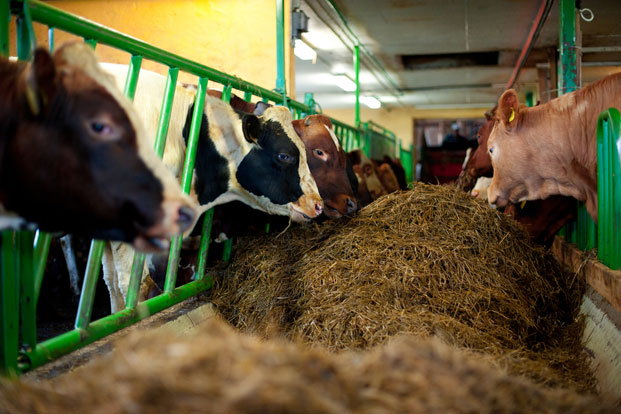People around the world were shocked when a 37-year-old Scottish horse trainer died from a disease that is rarely discussed in recent times. In fact, it’s a disease that many of us think has been wiped out.
So just what was the culprit that took the life of a young, healthy man?
We’ll give you one hint. Think back to the meat issue that affected the UK in the ’90s. It wiped out herds of otherwise healthy cattle and terrified consumers around the world. In truth, multitudes of people feared beef, even if no cases of the deadly predator had been discovered in their countries.
Have you figured it out yet?
The rare attacker that killed Mark Douglas was the human form of the deadly disease known as “Mad Cow Disease.” In truth, this killer has been widely forgotten. But the disease still exists, albeit much less often than they were at the height of the epidemic.
According to WebMD, mad cow disease is medically referred to as bovine spongiform encephalopathy, or BSE. When cattle develop BSE, the central nervous system is affected. This causes a progressive, fatal degeneration. It can be passed on to other cows and even people.
The FDA says that BSE itself is a part of a group of progressive degenerative disorders that are said to transmit spongiform encephalopathies, or TSEs. BSE incubates for several years. And during this time, the disease can’t be seen.
The question is: How do people become involved in a disease that strikes cattle?
The human health condition linked to mad cow disease is called Creutzfeldt-Jakob disease, the condition that took Mark Douglas’s life. And according to the Daily Mail, the diagnosis came as a shock to his family.
Douglas initially was taken to the hospital with strange symptoms that confused family members. He was then diagnosed with CJD just weeks before he passed away.
“We thought it can’t be CJD — he was the wrong age group and all sorts, but that was what he had,” Douglas’s girlfriend, Laura Baird, told Daily Mail. “It was a massive shock to us “
Douglas visited the hospital the first time two days before Christmas. However, medical experts couldn’t find the cause of his symptoms. A CAT scan, lumbar and blood tests revealed nothing. However, the correct diagnosis finally came three days after New Year’s Day. He then died on January 20.
CJD strikes very few people. The National Institutes of Health report about 300 cases in the U.S. annually; it strikes approximately one in a million worldwide.
This brings us to a second question: What is CJD? And why does it kill us?
According to the Mayo Clinic, CJD is a degenerative brain disorder that causes dementia and eventually leads to death. Here’s the thing: The disease itself can seem like other dementia illnesses. For example, it can resemble Alzheimer’s, which initially can confuse healthcare practitioners. That said, it’s different than dementia illnesses in that it progresses quickly.
This is where cattle come into play. Experts report that humans can contract the disease by eating beef products that contain central nervous system tissue. WebMD says that examples of this would be the brain and spinal cord. This is why these portions of cattle are taken out of the beef products that we eat — by law.
According to E-Medicine Health, the transmittable part of the disease is related to prions, abnormal protein particles that cause both the human and cattle-ridden form of the disease. They are said to be different than typical causes of spreadable diseases, like bacteria and viruses.
Generally speaking, prions are located in the brain, spinal cord and even the retina. But they also can reside in other areas like the spleen, bone marrow and lymph nodes, with low levels also found in the blood.
One of the most dangerous aspects of the disease is that cooking meat doesn’t change the risk, unlike other health risks meat may pose. And disinfectants and ultraviolet light don’t help.
That said, laws have been enacted that prohibit importing potentially affected animals from countries where the disease has been found. This ban extends to meat ingredients in the foods we eat as well as the foods that our animals and pets eat.
This is a good thing because when it comes to CJD associated with cattle consumption, it can be tough to tell just what’s going on until a person has severe symptoms. For example, WebMD reports that initially the disease can give off general symptoms, like depression and coordination issues. Then dementia will occur, which also can mislead healthcare professionals to misdiagnose the disease. Finally, as the disease advances, experts can piece all of the symptoms together. At this point, CJD can be detected due to brain abnormalities seen in an MRI. Patients will then die about 13 months after symptoms occur.
However, CJD itself isn’t just limited to connections with mad cow disease. In other words, CJD can develop without consuming beef. According to WebMD, CJD that is seen with mad cow disease is called variant CJD. But the other form of CJD is called sporadic CJD, also known as classic CJD.
In general, classic CJD strikes with age. It is said to be most common in older people over age 65. And like variant CJD, it is fatal, with patients dying in about six months once symptoms are seen.

Leave a Reply